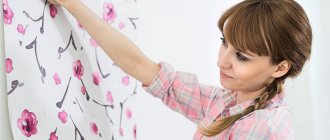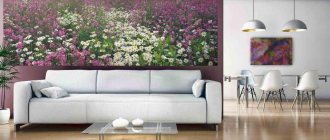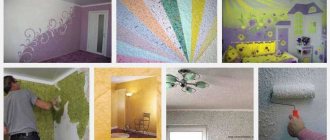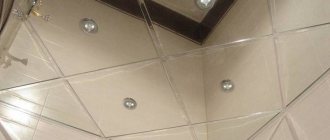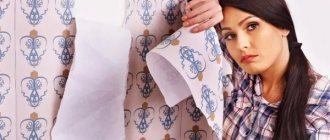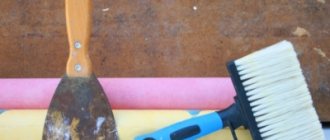The modern market is replete with many types of wallpaper, which sometimes makes the selection process very difficult. The materials differ from each other in structure, pattern, color, and texture.
Preparing walls for wallpapering...
Some types of coatings can be used exclusively in residential premises, while others can be applied even in rooms where conditions are characterized by high humidity. But if you need a coating that is resistant to abrasion and moisture, then you should prefer washable wallpaper, including vinyl materials.
In the production process of such wallpaper, artificial polymer is used. Washable vinyl coverings can have any texture, relief and color, which is their main advantage. If we consider the advantages over other types of wallpaper, we can highlight the ability to wet clean them.
However, there are also disadvantages, and the main one is airtightness.
Scheme for gluing wallpaper in the corners.
This means that condensation can accumulate under the canvas, leading to the appearance of mold. In order to avoid unpleasant consequences, you should follow certain rules when covering a room with washable wallpaper. One of the rules involves the use of special glue, which contains antibacterial agents.
There is another way to avoid the appearance of fungus under the surface of the wallpaper; it is to use washable wallpaper, which has a special coating equipped with micropores; it is they that help prevent moisture from passing through the room, and on the reverse side they provide the ability to breathe.
In addition to the fact that washable wallpaper can easily be wet cleaned, it is extremely elastic, which is good when shrinking a new house, in the apartments of which it is sometimes not recommended to make repairs during the first year after putting it into operation.
Vinyl washable wallpaper is recommended for use in those rooms that require additional sound insulation, since such material acts as a good sound absorber, which is due to the use of fleecy material in the production, which excellently retains sound.
Related article: Drywall cornice - a modern solution for curtains
Markings and features
Washable coatings are not a separate type of material, but its quality. Important information when choosing wallpaper is provided by the labeling, which shows whether the wallpaper is suitable for the kitchen, how resistant it is to liquids and what care it needs. You don’t need to be a specialist to determine which material is washable; it’s enough to know the meaning of the symbols. The photo shows the pictograms that are present on the wallpaper.
An important factor for wallpaper is moisture resistance, since kitchen materials must withstand a special microclimate and regular wet cleaning. The marking carries the following information:
- One wavy line indicates that the wallpaper does not tolerate moisture well and is washed carefully and rarely. Basically, these are coatings that are rarely used to decorate kitchen walls.
- Two wavy lines are denser wallpaper that can withstand washing with wet wipes and sponges. When washing wallpaper, you can use a mild soap solution.
- Three wavy lines are super washable wallpaper that can withstand cleaning with cleaning agents.
- Wave with a brush is a heavy-duty wallpaper that can be washed even with hard brushes.
- Three wavy lines with a brush are a high-end wallpaper that is rarely found on sale due to its high cost.
Light fastness indicators are also important - this is the period during which the print on the wallpaper fades and loses its original properties:
- Half sun - recommended for covering rooms where the sun's rays rarely penetrate, for example, with windows facing north.
- Half sun plus – gradual fading over the first year.
- Full sun - do not fade in direct rays for 7-10 years.
- Full sun plus or two suns do not fade at all.
All types of washable coatings have the following features:
- wear resistance and density of wallpaper;
- resistance to fading from sunlight;
- increased moisture resistance;
- resistance to cleaning using chemical detergents.
Washable wallpaper in the bathroom
Quite often, washable wallpaper is glued specifically in the bathroom. This solution has both pros and cons. The main disadvantage can be considered the effect of moisture on the material. Therefore, when gluing, you need to try to choose the highest quality coating so that it lasts on the wall for as long as possible. Pay attention to the photo:
In the next photo you can see a combined tile and wallpaper finish.
And the photo below shows how sometimes washable wallpaper makes the interior unique.
Types and coating of washable wallpaper
The main property that influences the perception of the kitchen environment is the type of wallpaper. Non-woven wallpaper is considered the best option for decorating kitchen walls. If you are choosing a material for painting, then it is better to take glass wallpaper, as they can withstand staining several times. Paper wallpaper is an unsuccessful way to decorate a kitchen, even if it has a water-repellent layer. They quickly discolor in the sun.
Paper
This is the simplest, cheapest and short-lived material. It quickly fades and loses its original appearance. Usually they decorate a part of the wall located far from the cooking area. When choosing paper material, film sheets with a water-repellent layer are preferred. They are coated with gloss, allowing them to be cleaned with a damp cloth.
The main advantage is low cost and a large selection of prints. Disadvantages include absorption of odors, fading from sunlight, difficulty in washing stains and a high probability of mechanical damage.
Vinyl
The most common material, which comes in several types: foam, flat and non-woven. The first two types are textured, which makes cleaning difficult, while the third type is easy to clean and meets all kitchen requirements. There are washable samples with high-quality imitation of other coatings, for example, stone, wood, brick.
The advantages include a variety of textures and colors, the ability to imitate different surfaces (stone, brick, tile), masking unevenness on the walls, strength, and moisture resistance. The disadvantages are poor air circulation, which leads to the formation of mold, and the likelihood of peeling off due to sudden temperature changes.
Fabric
These are vinyl coverings, the base of which adds strength to them. They last much longer than paper ones. The advantages of this type include the uniqueness and natural component of the material, beauty, long-term operation (several decades with proper care). The disadvantages are that they strongly attract dust and absorb kitchen odors.
Non-woven
Material made from cellulose. Unlike paper wallpaper, this wallpaper is denser. They have a multi-layer structure, and the relief is applied only to the top layer. Advantages - they hide minor imperfections, have a “breathable” surface (they allow air to pass through well), are resistant to dust, dirt, moisture, and do not absorb aromas. For some, the disadvantage is the high cost of the material.
Acrylic
The wallpaper is thinner than the previous ones, but has a higher density. The main advantage is the ability to “breathe”, but for the kitchen this property is not paramount. They are appropriate in classic designs, as they have a surface with a velvety texture.
Metallized
Wallpaper with metallic fibers creates a stylish effect. They can be cleaned with a damp cloth and do not lose their original appearance for several years. The main disadvantage is poor air permeability. Often wallpaper comes with a coating - copper, gold, silver, bronze.
Glass wallpaper
This is an environmentally friendly material that surpasses previous types in its quality characteristics. It does not catch fire in the event of a fire and is easy to clean. In addition, the coating is not susceptible to mold. It is glued to an untreated surface, since the canvas hides all the unevenness on the walls, and is also painted several times in a row. The disadvantages include high cost and a small selection of textures.
Liquid
A modern material that looks completely different from the usual wallpaper. This is a granular substance that is diluted in water and applied to the walls. The advantage over other types is the ability to add decor to the mixture, for example, sparkles, beads. The result is a smooth surface without joints. But not all types of liquid wallpaper are resistant to moisture; some cannot be wetted at all.
Natural
An eco-friendly type of wallpaper with a safe composition, which cannot be said about other types. These are cork and bamboo coverings. A good option for kitchens in ethno style. They resist elevated temperatures and liquids. The disadvantages include a small selection of designs. To prevent the material from absorbing odors, it is coated with a protective varnish.
Photo wallpaper
They allow you to effectively design the kitchen, decorate and update the furnishings. In small kitchens, they can be used to visually increase the area by choosing the appropriate design. For the kitchen, it is recommended to choose wallpaper with lamination so that it can be washed.
The advantages include resistance to moisture, grease, dirt (but only coatings with a varnished surface), the disadvantages are that they are not suitable for finishing a work area, there is a possibility that the bright print may become boring.
Design selection
No less popular are wallpapers that imitate natural materials. Here are the most common:
- Decorative stone is appropriate for kitchens in loft, country and Provence styles. Stone coating combines well with other materials. Wallpaper can be one color or with a small ornament.
- Brick. Also suitable for loft and Provence. Available in a large selection of colors, shapes and prints, which allows you to choose a coating to suit any design.
- Under the tiles. This wallpaper can be used to decorate all walls or a separate work area. Often such wallpapers are combined with other coatings.
- Tree. A coating that has been popular for several years. Natural wood is rarely used in kitchen decoration, but wallpaper with its imitation is perfect.
- Checkered print. It can be voluminous, small, monotonous, Scottish. A plain kitchen set to match the wallpaper goes well with checkered walls.
Check print
Under the tree
- Flowers. Floral prints will never go out of style. Flowers indicate the mood in the kitchen, for example, graceful orchids give the interior brightness and tenderness, and pink peonies add romance.
- Bamboo. These are vinyl coverings with an imitation of natural material, only unlike it, it is available in a large selection of colors. Wallpaper can also replicate bamboo stems with leaves, which is used in Japanese style.
Eventually
Drawing conclusions, we can say with confidence that gluing washable wallpaper is justified and not difficult. After all, you can easily rid the surface of almost any dirt. In the bathroom, washable wallpaper can also be installed, and with the help of the photos used in the article, you can choose a design. We recommend watching a video that will help you learn more about this coating:
Recommended Posts
3d wallpaper for the living room + photo
How to properly glue wallpaper on drywall with and without putty…
How to hang wide wallpaper
Beige wallpaper in the interior
Brick wallpaper in the hallway and corridor
Erismann wallpaper in the interior
Color selection
The color of wallpaper for the kitchen is chosen based on the style and dimensions of the room. Dark colors are not suitable for small kitchens, as they visually narrow the space, so it is better to choose light colors with a small pattern. In spacious kitchens, the choice of shade is unlimited. Ideal kitchen shades are:
- White. This color has many advantages. It can be combined with different shades, it is appropriate in any style and visually enlarges the kitchen. White can be a basic color or combined with bright contrasts.
- Green. The choice of shades is large - from fresh greenery to dark olive. Saturated colors are best used in a large kitchen with good lighting. Also, the color should be in harmony with the kitchen style, for example, bright colors are appropriate in modern styles, and muted colors for classic ones.
- Beige. This is a universal color suitable for any style and size of kitchen. It appears in one finishing color or harmonizes with a bright palette.
- Black. This color is chosen only for large, open kitchens. More often it is found in ornaments on washable canvases.
How to choose waterproof wallpaper
The choice of finishing material is influenced by: the size of the kitchen, the south or north side, the budget, as well as the characteristics of the wallpaper. Before purchasing, it is better to ask for quality certificates, which contain information not only about the labeling, but also the composition and care recommendations.
You need to check each roll before purchasing. Deformation of even a small fragment of wallpaper will affect the repair as a whole. When studying certificates, they evaluate:
- Vapor tightness means that the wallpaper will not come off the walls when exposed to vapor. This is important if you plan to tape the work area.
- Light resistance - this parameter is especially important if the windows are on the south side, otherwise after a short time the print will fade and the repair will have to be redone.
- Density - the higher this indicator, the more resistant the coating is to mechanical stress.
Step-by-step instructions on how to glue
Most washable wallpaper for the kitchen is heavy, so the adhesive is selected accordingly. Before starting work, the surface of the walls is prepared, and the work is performed in accordance with the rules:
- Prepare the walls - remove the old covering, clean it of dust, dirt and dry it. Some types of wallpaper, for example, paper, photo wallpaper, require preliminary leveling of the walls. Then the surface needs to be primed and large flaws and cracks filled with putty.
- Then you need to apply markings - draw a straight line from the ceiling to the floor using a building level, which will become a guide when gluing the wallpaper.
- Prepare the material by cutting the wallpaper into strips of the desired size. Be sure to allow an allowance of 10 cm.
- Depending on the type of wallpaper, apply glue to the walls or strips and apply to the wall. Carefully process the joints - they should be well coated.
- Straighten the wallpaper with a rubber roller, rolling it from the middle to the edges.
Excess glue on the wallpaper is removed immediately. At the end of the work, excess wallpaper is trimmed with a sharp knife.
Material overview
Types of washable trellises
In principle, the main characteristic of washable wallpaper is its ability to withstand periodic moistening and cleaning using brushes and other means.
At the same time, depending on the material used in the manufacture, trellises are divided into the following groups:
- Washable vinyl wallpaper for the kitchen is the most popular type . They are a film made of smooth, foamed or corrugated PVC, applied to a base of non-woven fabric or thick paper.
- The service life of such wallpaper for decoration is about 15 years . Today, manufacturers of almost all varieties of this material impregnate the base with fungicides and antiseptics, which minimizes the risk of damage to the finish by bacteria and fungi.
Note! Some models of vinyl trellises are characterized by the additional use of silk or synthetic threads fused into the vinyl coating. Such silk-screen printing does not in any way reduce the abrasion resistance of vinyl.
Photo of vinyl trellises with a kitchen-themed pattern
- Textile wallpaper can also be used to decorate rooms with high humidity . Since flax or cotton fibers themselves do not resist getting wet well, a Teflon coating is applied to the textile layer. By the way, it greatly facilitates the removal of contaminants from such wallpaper - dust, drops of grease, etc.
- Another type of washable trellis is non-woven . In terms of durability, they are somewhat inferior to vinyl, but are also quite suitable for kitchens. The impregnation of the fabric itself, as well as acrylic and latex paints, which are applied to walls already covered with wallpaper, are responsible for the water-repellent properties of this material.
- Washable, cheap wallpaper for the kitchen is a regular roll of paper with a printed pattern, impregnated with a special compound to protect it from getting wet . This type is the least reliable, since the impregnation rarely withstands intense exposure to brushes or household chemicals for more than several years. Then we have to carry out new repairs.



